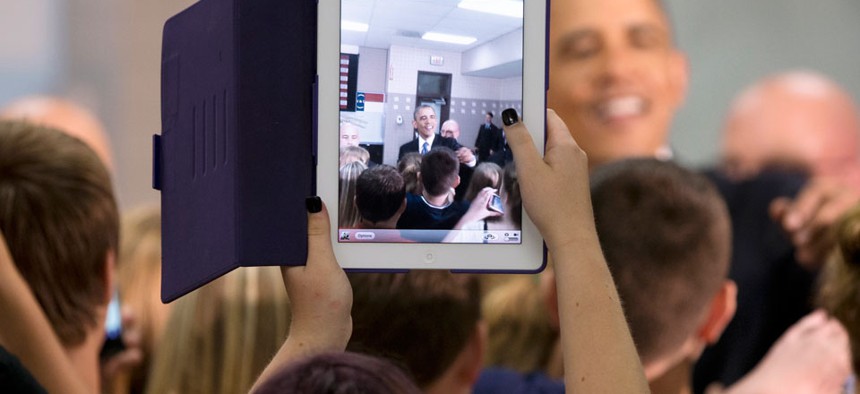Making the President Viral

Evan Vucci/AP
Obama’s digital reelection team focused on what the president’s supporters wanted their friends to think they liked.
LOS ANGELES -- Job No. 1 for most political campaigns is to persuade undecided voters to support their candidate. The digital team working on President Obama’s reelection campaign had a different goal: persuading supporters to reach out to their most persuadable undecided friends.
The campaign started with two pieces of data, the campaign’s digital director Teddy Goff told an audience at LA Social Media Week on Monday. They knew that 99 percent of people on their mailing list were already Obama supporters. They also knew that if you added up all the Facebook friends of people who “liked” the president’s Facebook page you’d have 98 percent of all American Facebook users. That amounts to more than the total number of people who vote in presidential elections.
“The people we’ve got are already with us,” Goff said. “So any time we spend trying to persuade them, trying to get them to vote, trying to tell them why they should vote for President Obama is time we ought to have spent doing something else. We also know collectively those people can go out and reach almost everyone else in the country.”
The campaign famously used its Facebook network and troves of data in the last days before the election to ask followers to reach out to a list of friends in swing states it believed were both undecided and could be persuaded to vote for the president. An analysis showed more than 70 percent of people contacted this way who voted cast their ballots for the president, Goff said.
The team also targeted those persuadable voters in the months leading up to Election Day, though, by sharing content that analysis showed their friends would be most likely to share, Goff said.
“When they reach those people they’re reaching them with a lot more credibility than we as a campaign can,” he said. “Because people don’t trust politicians, they don’t trust rhetoric they don’t trust speeches, they don’t trust advertisements …but study after study shows they trust their friends.”
Here are some lessons, the team learned:
- People don’t share what they like on Facebook or Twitter; they share what they want their friends to think they like.
That means there are diminishing returns if you aim too low or are too snarky, Goff said. Instead the digital campaign team aimed for simple, relatable and largely non-partisan posts on specific topics, such as education, immigration and gay rights.
- Data still matters.
The campaign got a lot of shares from data-heavy posts, Goff said, so long as they were simple and visually appealing, such as a bar chart of monthly jobs created, running from the tail end of the Bush administration through Obama’s first term.
People also pay attention to sources, he said. The team tested that graphic with and without a note attributing the data to the U.S. Bureau of Labor Statistics and found it fared better with attribution.
- People will swallow complex policy if it’s presented in an engaging way.
At one point the team produced a webpage that purported to offer details about Republican nominee Mitt Romney’s tax plan except the “get details” button ran away whenever the cursor touched it. (The idea was that Romney was being evasive about providing details).
The post received 1 million Facebook likes. More tellingly, Goff said, 1.5 million people clicked through to a primer on Obama’s tax policy, and analytics showed many of them read to the end of the plan.
--
Join us at Nextgov Prime Oct. 15-16 in Washington for indepth discussions about cloud computing, data security and much more. Registration is free for federal employees.



